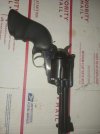Josh
Well-Known Member
It's my luck, but at least I know how to fix it. It happens a lot. That said, a quick hour of work and it's a hammer with cast or jacketed.Josh--There it is there, I knew it had to occur to someone. I just haven't seen it myself, and no one I knew had encountered the anomaly either.

